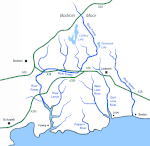Lerryn
Use British English from July 2016Villages in Cornwall

Lerryn (Cornish: Leryon, archaically Lerrin) is a village in Cornwall, England. It is situated on the River Lerryn (a tributary of the River Fowey) approximately three miles (5 km) southeast of Lostwithiel. Lerryn straddles two parishes: north of the river it is in St Winnow parish and south of the river in St Veep parish. The river is tidal up to the village and there are stepping-stones across the river which are crossable at low water.
Excerpt from the Wikipedia article Lerryn (License: CC BY-SA 3.0, Authors, Images).Lerryn
Geographical coordinates (GPS) Address Nearby Places Show on map
Geographical coordinates (GPS)
| Latitude | Longitude |
|---|---|
| N 50.3834 ° | E -4.6173 ° |
Address
PL22 0PT , St. Veep
England, United Kingdom
Open on Google Maps








